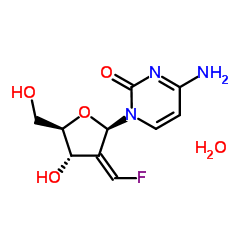Tezacitabine
Modify Date: 2025-08-27 19:55:42

Tezacitabine structure
|
Common Name | Tezacitabine | ||
|---|---|---|---|---|
| CAS Number | 130306-02-4 | Molecular Weight | 275.234 | |
| Density | N/A | Boiling Point | 590.1ºC at 760 mmHg | |
| Molecular Formula | C10H12FN3O4 | Melting Point | N/A | |
| MSDS | N/A | Flash Point | 310.7ºC | |
Use of TezacitabineTezacitabine is a cytostatic and cytotoxic antimetabolite and a nucleoside analogue. Tezacitabine irreversibly inhibits the ribonucleotide reductase and interferes with DNA replication and repair. Tezacitabine effectively induces cells apoptotic. Tezacitabine has the potential for leukemias and solid tumors (carcinomas) treatment[1][2]. |
| Name | 4-amino-1-[(2R,3E,4S,5R)-3-(fluoromethylidene)-4-hydroxy-5-(hydroxymethyl)oxolan-2-yl]pyrimidin-2-one |
|---|---|
| Synonym | More Synonyms |
| Description | Tezacitabine is a cytostatic and cytotoxic antimetabolite and a nucleoside analogue. Tezacitabine irreversibly inhibits the ribonucleotide reductase and interferes with DNA replication and repair. Tezacitabine effectively induces cells apoptotic. Tezacitabine has the potential for leukemias and solid tumors (carcinomas) treatment[1][2]. |
|---|---|
| Related Catalog | |
| Target |
Ribonucleotide reductase[1] |
| In Vitro | Tezacitabine (0.01-10 µM; 24 hours; CCRF-SB, KG-1, Jurkat, COLO-205, MCF-7 and PC-3 cells) treatment induces the G1 and S-phase leaky block of the cell cycle[1]. Tezacitabine (0.01-10 µM; 24 hours; CCRF-SB, KG-1, Jurkat, COLO-205, MCF-7 and PC-3 cells) treatment apoptotic death of cells by the caspase 3/7 pathway in a concentration-dependent manner[1]. Tezacitabine has strong cytostatic and cytotoxic properties. Cytotoxic effect of Tezacitabine reveals not only as apoptosis, but also as a change in protein metabolism[1]. Cell Cycle Analysis[1] Cell Line: CCRF-SB, KG-1, Jurkat, COLO-205, MCF-7 and PC-3 cells Concentration: 0.01 µM, 0.1 µM, 1.0 µM, and 10 µM Incubation Time: 24 hours Result: Induced the G1 (at concentrations higher than 10 nM) and S-phase (at low concentration) leaky block of the cell cycle. Apoptosis Analysis[1] Cell Line: CCRF-SB, KG-1, Jurkat, COLO-205, MCF-7 and PC-3 cells Concentration: 0.01 µM, 0.1 µM, 1.0 µM, and 10 µM Incubation Time: 24 hours Result: Induced apoptotic death of cells by the caspase 3/7 pathway in a concentration-dependent manner. |
| In Vivo | Tezacitabine (100 mg/kg; intraperitoneal injection; daily; female nude mice) treatment inhibits tumor growth in HCT 116 tumor xenografts[2]. Animal Model: Female nude mice (7-9-week-old) injected with HCT 116 cells[2] Dosage: 100 mg/kg Administration: Intraperitoneal injection; daily; 14 days Result: Inhibited tumor growth in HCT 116 tumor xenografts. |
| References |
| Boiling Point | 590.1ºC at 760 mmHg |
|---|---|
| Molecular Formula | C10H12FN3O4 |
| Molecular Weight | 275.234 |
| Flash Point | 310.7ºC |
| Exact Mass | 275.091736 |
| PSA | 110.60000 |
| MDL 101,731 |
| tezaciabine |
| FMdC |
| tezacitabine |
| 2'-Deoxy-2'-(fluoromethylene)cytidine hydrate (1:1) |
| Fmdc cpd |
| Cytidine, 2'-deoxy-2'-(fluoromethylene)-, hydrate (1:1) |